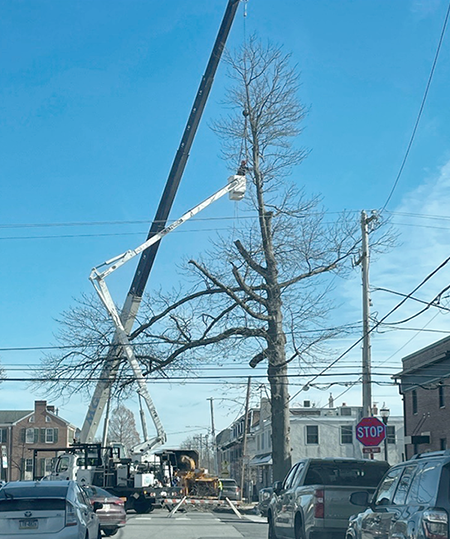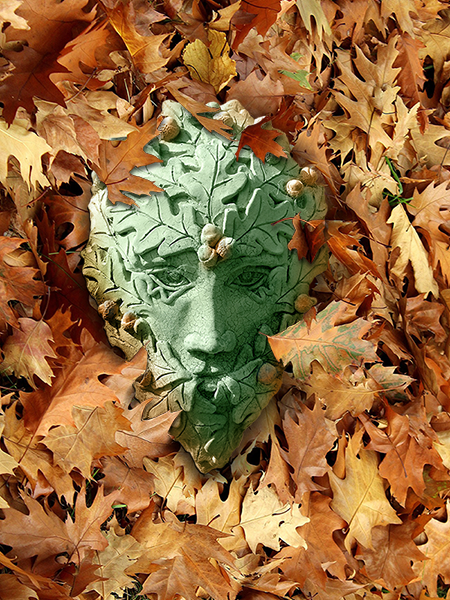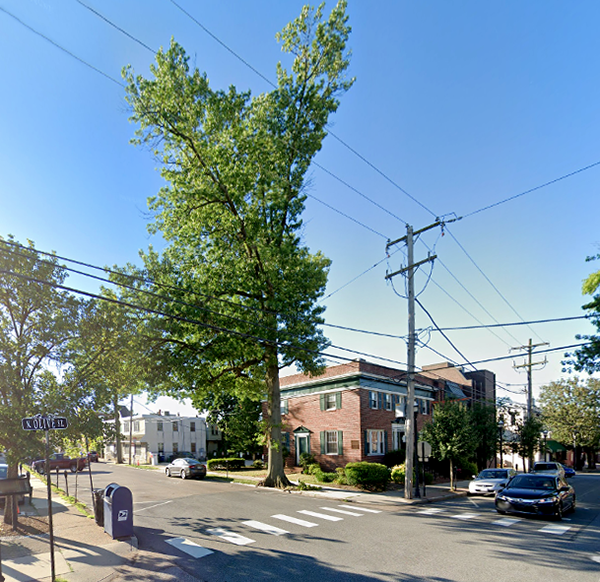We had just concluded our meeting of the Tree Lovers Collective,and we stepped into the brisk, sunlit streetscape on Front Street in Media Borough. A chainsaw growled down the block from us. The four of us looked up and saw the cranes and cherry pickers. A tree was “being removed”.
“Oh no,” said one of us quietly.
Another looked down and shook her head.
A quiet prayer seemed to pass over us. We are the Tree Lovers, after all, and one of our beloved old oak trees was being removed.
We scattered and my path took me closer to the tree being hacked to pieces and ground to dust. I wanted to document the moment, so I set my portfolio on the ground, filled with folders of research and notes.
As I took a photo, a burst of angry wind blew through me. My heavy binder on the ground was thrown open and my papers were shot down Front Street like fodder from a cannon in a stern rebuke.

The old oak tree taking its final breaths
I was taken aback.
I immediately felt the anger of the wind. It felt like I was being scolded by nature, “How dare you photograph their death—and do nothing about it!?”
This thought sat with me for three days.
On the first day, I resolved to do something about it.
On the second day after the old Oak’s death, I stopped by the stump and said goodbye, thanking it for all the good things that it had done for our community.
I also learned on that day that some tree loving friends were stopping to pay their respects to the stumps.
The story behind the tree’s demise unfolded. The tree is a Media Borough tree since it lines the public street. A new owner has taken over the corner office building and is pursuing a substantial renovation. Apparently, this owner requested the tree be considered a threat. A certified arborist that worked for a commercial tree removal company, assessed the tree and deemed it in “fair to poor condition”, that should be considered for removal. It doesn’t appear that anyone asked if the tree could just be pruned.
On the third day after the loss of our neighbor, I wrote this blog post.
Voice of the Wind
If the wind had a voice and could share what it felt about this tree, I think it would say something like:
“My friend… our friend… is being taken from its home of decades. It has raised its arms and cooled your sidewalks on a hot day. It drank your stormwater, keeping your homes safe. It lapped up the falling rain, preventing it from ever touching the earth.
And no one has spoken out for them. No one came to witness this loss of life. And why?Because it does not move like an animal? Because it cannot speak like a person?
It was a living being who contributed to your community. Did it get any consideration for its value and years of service? It seems not.
Please remember this oak.

Perhaps next time, someone will bear witness to such a tragedy. And its death will not have been in vain.“
Some Facts

The Unnamed Oak stump is under the orange cones
- The likelihood of being killed by a fallen tree is somewhere between 1 in a million and 1 in 10 million. You are more likely to be struck by lightning.
- In a recent survey conducted by Bryn Mawr math students under the supervision of Transition Town Greater Media, the students found in the roughly six blocks around the Delaware County Courthouse Complex, there are 153 total trees.
- These trees alone intercept over 109,000 gallons before it touches the ground. An additional 19,872 gallons of stormwater are kept out of our drains and off streets, parking lots and sidewalks.
- The tree of this story is literally an unnamed oak. It did not show up in the Bryn Mawr student’s study. It was also missing from a 2017 Borough-wide tree survey done by the Borough’s Tree Warden. Therefore, I will refer to it as the Unnamed Oak.
- By itself, this Unnamed Oak was 36” inches in diameter. Over a 20 year period, it absorbed an estimated equivalent of 6,000 of CO2 from the atmosphere, avoided 7,664 gallons of runoff, and intercepted 42,298 gallons of rainfall (meaning it never touched the ground). This giant sponge has also been generating oxygen to our benefit.
Why Are We Terrified of Trees
Most people who don’t study trees just see them as very large objects that seem like they could topple over and crush anything in its path. Some people see their aesthetic value, but few realize that trees are a crucial part of our infrastructure.
That’s right! Trees are key participants in keeping our homes, streets and streams safe from unmanageable rainwater by absorbing enormous amounts of water. They stabilize slopes. They provide us with breathable oxygen and absorb vast amounts of greenhouse gas. They cool the town in the summer.
The sooner we can change our view of trees as expendable objects that can be chopped down when they are inconvenient to a view of important natural infrastructure made from living beings that have taken decades, even centuries, to be grown.

What can we do?
- Practice viewing trees as silent, but helpful, neighbors. Remember they are living beings.
- If you know about a tree being removed, ask the decision makers if removal is necessary. Have they considered alternatives?Pruning and other types of care can usually remedy many concerns.
- Consider holding an acknowledgement service near the tree before or while it is being removed. Such a service can raise awareness of the value we are losing each time a tree is removed.
- Spend a moment when you walk by a stump and give thanks for the service that tree had provided.
- We need to keep planting, nurturing, and maintaining trees in our community. They provide enormous benefits to us humans—and to vast webs of insects, birds, and animals.
Thanks for considering a new perspective on trees.

Beautiful blog, Skip.
Wonderful, sad essay. I am currently reading “The Hidden Life of Trees” and am astounded by what I’m learning about the complexity of their lives and communities. It makes me even sadder for the losses in Media and on my street just outside Media. A few years ago, we had a storm that blew over a large tree from our neighbor’s yard onto their car, on the street. A few weeks afterward, they suddenly cut down almost all of the large trees in the front yard of their house. Because they could. A few years after that, they moved away.
That story really hit home. Thank you for raising awareness that we need to respect what we cannot live without